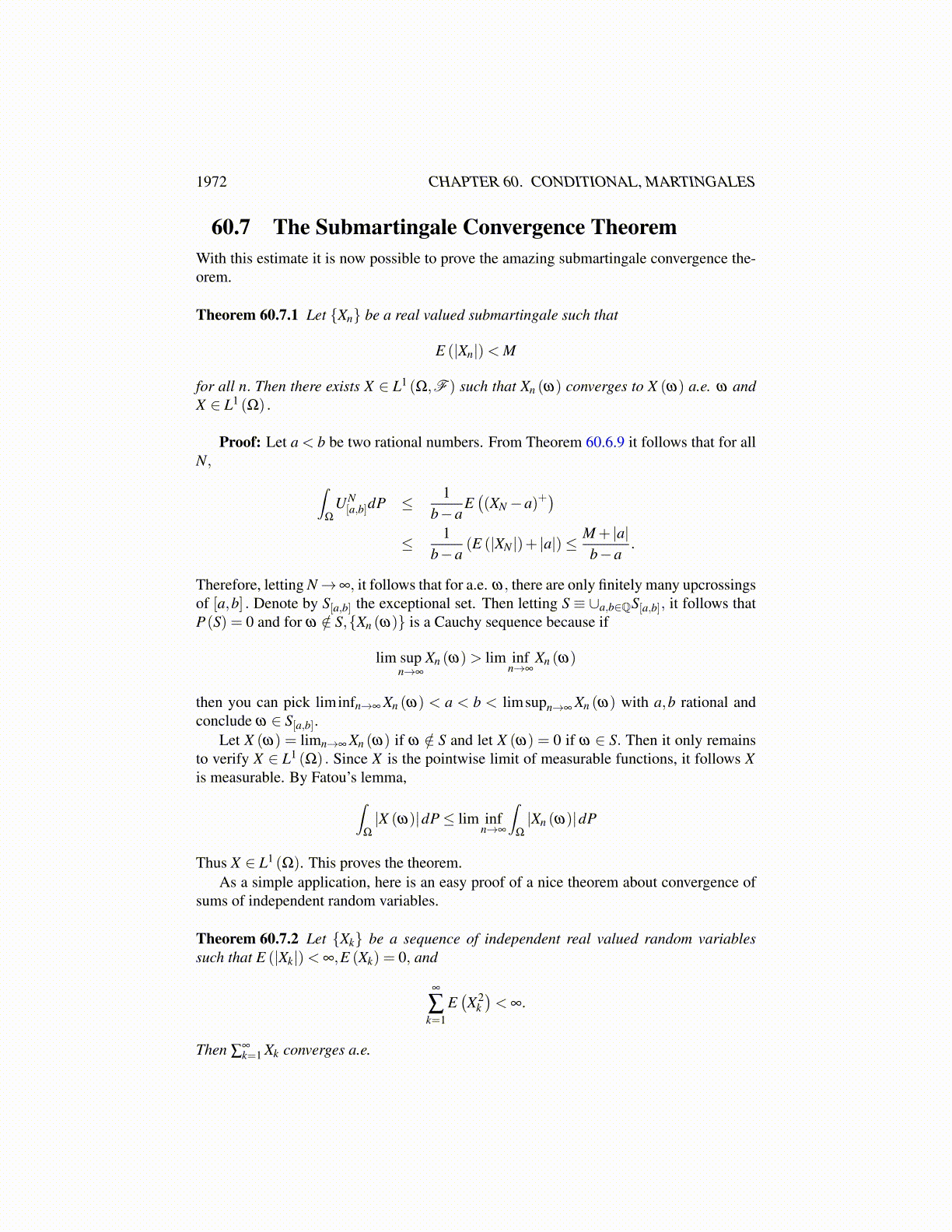
1972 CHAPTER 60. CONDITIONAL, MARTINGALES
Example 60.6.7 Let {Fn} be an increasing sequence of σ algebras contained in F where(Ω,F ,P) is a probability space and let {Xn} be a sequence of real valued random variablessuch that Xn is Fn measurable. Also let a < b. Define
T0 ≡ inf{n : X (n)≤ a}
T1 ≡ inf{n > T0 : X (n)≥ b}T2 ≡ inf{n > T1 : X (n)≤ a}
...
T2k−1 ≡ inf{n > T2k−2 : X (n)≥ b}T2k ≡ inf{n > T2k−1 : X (n)≤ a}
If Xn (ω) is never in the desired interval for any n > Tj (ω) , then define Tj+1 (ω)≡∞. Thenthis is an increasing sequence of stopping times.
It happens that the above gives an increasing sequence of stopping times.
Lemma 60.6.8 The above example gives an increasing sequence of stopping times.
Proof: You could consider the modified random variables
Y (k)≡ (X (k)∨a)∧b
Then these new random variables stay in [a,b] and if you replace X (n) in the above withY (n) , you get the same sequence of stopping times. Now apply Lemma 60.6.5.
Now there is an interesting application of these stopping times to the concept of up-crossings. Let {Xn} be a submartingale such that Xn is Fn measurable and let a < b.Assume X0 (ω)≤ a. The function, x→ (x−a)+ is increasing and convex so
{(Xn−a)+
}is also a submartingale. Furthermore, {Xn} goes from≤ a to≥ b if and only if
{(Xn−a)+
}goes from 0 to ≥ b−a. That is, a subsequence of the form Yn (ω) ,Yn+1 (ω) , · · · ,Yn+r (ω)for Y equal to either X or (X−a)+ starts out below a (0) and ends up above b (b−a) .Such a sequence is called an upcrossing of [a,b] . The idea is to estimate the expectednumber of upcrossings for n ≤ N. For the stopping times defined in Example 60.6.7, letT ′k ≡ min(Tk,N) . Thus T ′k , a continuous function of the stopping time, is also a stoppingtime which is bounded. Moreover, T ′k ≤ T ′k+1. Now pick n such that 2n > N. Then for eachω ∈Ω
(XN (ω)−a)+− (X0 (ω)−a)+
must equal the sum of all successive terms of the form((XT ′k+1
(ω)−a)+−(
XT ′k(ω)−a
)+)for k = 1,2, · · · ,2n. This is because
{T ′k (ω)
}is a strictly increasing sequence which starts
with 0 due to the assumption X0 (ω)≤ a and ends with N < 2n. Therefore,
(XN−a)+− (X0−a)+ =2n
∑k=1
(XT ′k−a)+−(
XT ′k−1−a)+